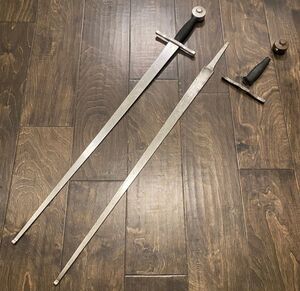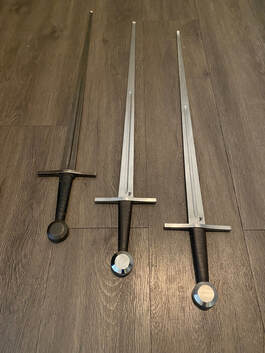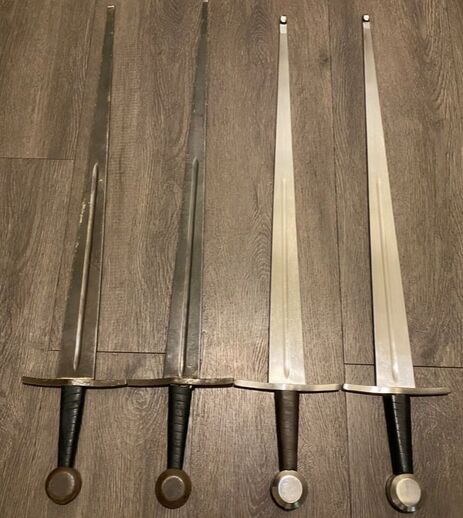|
One of my go-to tournament arming swords is the Full-Contact I.33 Sword by Regenyei Armory. I first purchased this sword back in 2018, and unfortunately, it finally broke while sparring at the end of 2023. This sword has been a workhorse for me through the years, and I am excited to review it for you today! MeasurementsBelow is a table including the measurements I took of my sword I purchased in 2018 and my 2023-purchased sword. I also included the reported measurements from Purpleheart Armory and HEMA supplies converted from cm to in. Note that the measurements of the 2018 sword were taken after years of use and after the sword was broken. DurabilityThis sword has been one of the most durable swords used in my class and proved to be low maintenance. One of the advantageous of this sword and why I suspect it gets the “full-contact” label by Regenyei is the blade construction which lacks a fuller and has well-rounded edges. The lack of fuller makes cleaning the blade simple because it is a flat surface. The rounded edge reduces the chance of chips and burs forming. After nearly 5 years of use, I have never had to file the edge of the blade for safety purposes. The 2018 blade is still generally smooth after years of use as seen in the following image. However, the sword is not invulnerable. The first issue that occurred was the crossguard becoming loose. This happened because the handle's wood core was compressed and chipped enough to free the crossguard. I tried to extend the handle with leather spacers and attempted to use washers to secure the crossguard, but eventually, it would come loose again. However, this has occurred with most of my arming swords from various makers given enough time. Another issue was that the wrap on the handle eventually had to be replaced. This is a common issue for cord wraps because they begin to unravel once they are struck and the cord is cut. Brittany Saint Leafy has an excellent video on re-wrapping a cord wrap on a sword that one of my students has used. I opted to use a leather wrap to replace the cord wrap, which did not have to be replaced after being applied. The sword ultimately broke from a strike against the pommel from a Regenyei messer that sheared the pommel from the blade. Since the sword is peened, repairing it was not possible without serious blacksmithing. This was not the first strike against the pommel the sword had received, so it was likely just multiple strikes against the pommel that eventually led to the failure. CostAt the time of writing this review, in the United States, the sword can be found at Purpleheart Armoury for $240.00 plus shipping and handling. Alternatively, the sword can be found for $300.00 plus shipping and handling at HEMA Supplies. Aesthetics The Full-Contact I.33 Sword by Regenyei Armory is about as simple as a sword can get in HEMA. Without a fuller and with the blade being flat, the sword loses a great deal of aesthetic value. While the sword is balanced well and feels like other swords I have, the Full-Contact I.33 Sword lacks the look of a sword to a certain degree especially when compared to Regenyei’s other I.33 swords available. Feel and HandlingWhile this sword lacks some features that make it look more like a sword, the handling of the full-contact I.33 sword certainly feels like a sword. This sword handles like the Standard I.33 Arming Sword I by Regenyei, which features a diamond profile on the blade. The sword has a great binding presence while effectively being weighted for cutting and thrusting actions. With the tapering of the blade, the sword is well balanced while still having enough weight and feeling to feel present in the hand. While using this sword, you can feel how it is moving and the responses in the bind, making it very effective for executing I.33 techniques. The blade also has some flexibility to protect fencers when receiving a thrust. However, like many arming swords, the flex is not as much as seen in the longer feder blades of longsword in HEMA. Commentary on it being a “I.33 Sword”This sword is excellent in binding and can execute cuts and thrusts. The crossguard is a great size for keeping the sword hand safe while not getting in the way of buckler actions when the hands are kept together. I have had no problem executing I.33 techniques with this sword and have chosen to use this sword over others in HEMA tournaments. However, One of my bigger pet peeves in HEMA gear is advertising a sword for a specific system. Regenyei advertising this sword as an “I.33” sword is like Albion advertising their “I.33” sword or other companies making “Fiore” swords. For new fencers, it can be helpful to be directed to a specific sword for their study source. However, this type of marketing can also give the wrong impression of what swords can and cannot be used for I.33. it also can present the wrong impression that this sword can only be used for I.33 techniques instead of other sword and buckler techniques like Paulus Kal. From a historical perspective, the art in the manuscript is not consistent enough to pinpoint a specific Oakeshott sword typology. Furthermore, the late 13th century to the early 14th century, when the manuscript was likely written, was a period of quite a large amount of variation in the traditional arming swords that are available. David Rawlings has an excellent video discussing this topic that I recommend for more information. Can this sword be used to execute I.33 techniques? Yes. Is this THE sword shown in the I.33 manuscript? Even if the full-contact I.33 sword had a diamond profile like the standard I.33 sword I by Regenyei, the answer would be inconclusive based on the art and the swords available at the time. Who I recommend it to When compared to the $225.00 Type XVI sword by VB currently available at Purpleheart Armoury, the Full-Contact I.33 Sword is a great arming sword at any fencing experience level. I would recommend this sword slightly over a Type XVI sword by VB because of the variability discussed in the product review for that sword. However, this sword may not be for everyone due to the lack of fuller and simple aesthetics. That being said, do not make the mistake of assuming the lack of aesthetics translates to not feeling like a real sword. This is a great training arming sword. Closing ThoughtsFor tournaments, I have been switching between my standard I.33 sword I by Regenyei and the full-contact I.33 sword by Regenyei. While I like the look of the standard I.33 sword more, the blade has a habit of getting chips and burs that I need to file out before and after use.
This highlights the main advantage of the full-contact I.33 sword for HEMA tournaments: the durability. In tournaments, various swords of different steels and weights are used, and this sword has proven to take a beating while still not damaging the blade. The sword has kept its shape with minimal damage, even against strong cuts aimed at breaking through my defense. The sword’s weight and handling allow me to execute the techniques I study, which makes it an easy recommendation for all HEMA practitioners at all levels.
0 Comments
As much as I love the Type XIV Arming sword by Viktor Berbekucz (VB), the sword has not been as popular in my class with my students. Many of my students feel that the shorter stockier blade is hard to manage. Instead, many of my students have looked at a different VB sword for their first sword. Today we are going to discuss my thoughts on the Type XVI Arming Sword by Viktor Berbekucz and why it has become the most popular sword in my sword and buckler class. We will compare the characteristics of multiple Type XVI swords by VB and minor differences I have seen between them. Please note: I have linked the primary website for the sword to help assist in purchasing regardless of region. However, I purchased mine from Purpleheart Armoury. DurabilityJust like with all the one-handed VB swords I have used, the Type XVI sword shows remarkable durability. If you are looking for a training sword that will last for years, the Type XVI sword by VB is a solid choice. Just like with all the arming swords I have trained with, the crossguard will inevitably become loose and rattle. Originally I was able to hammer the crossguard back to being secure but I am unable to do so now on the older type XVI swords I have. Instead, I have been using epoxy to hold the crossguard in place. CostViktor Berbekucz swords continue to be one of the most affordable swords on the market (at least in the United States). With the price and the durability, these swords make a fantastic beginner sword purchase. AestheticsThe Type XVI sword by VB features a straight crossguard and a fuller running up the blade. The sword is a simple and functional design that serves its purpose. VB does offer the Type XVI sword with both a wheel pommel and a pear pommel. This allows for a bit of customization and personal preference that is not normally seen with VB swords. However, be aware that some of the pear pommels have been observed having variability in hilt length. Variability in Feel Each Type XVI sword I have handled by VB has had its own feel to it. This is partially due to the handcraftsmanship and also due to the span of time when comparing Viktor Berbekucz’s swords. While the newer swords feel more standardized, they still all seem to have their own balancing and handling. To further illustrate the variability, let’s take a look at the Type XVI sword by VB in my collection. The Outlier (Purchased in 2019) Overall Length 39.0 in Blade Length 31.2 in Grip Length 5.3 in Weight 1124 grams Blade Width at Crossguard 1.52 in Blade Width at Tip 0.44 in POB Passed Crossguard (Approx.) 3.5 in Crossguard Length 6.3 in Crossguard Thickness 0.38 in This Type XVI purchased in early 2019 has always stood out as an outlier in Type XVI swords by VB. The sword is far lighter and more nimble than other Type XVI swords by VB but struggles the bind. While this sword is an outlier because of its weight, it is also the more popular of the Type XVI swords I have to available in my class. The lighter blade is perfect for brand new students who are still getting used to the feel and handling of the sword. However, even though it is popular, I see this sword as an outlier and is not the sword I would expect to receive if I purchased it in 2022. Thick Crossguard (purchased in 2021)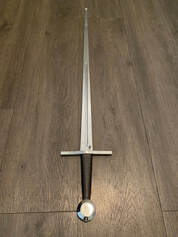 Overall Length 38.5 in Blade Length 31.2 in Grip Length 5.0 in Weight 1232 grams Blade Width at Crossguard 1.60 in Blade Width at Tip 0.48 in POB Passed Crossguard (Approx.) 3.5 in Crossguard Length 6.2 in Crossguard Thickness 0.40 in This sword was purchased in early 2021 and has a similar feel to the next sword on the list. Again, the standardization of the swords shows how Viktor Berbekucz is honing his craft. One difference this sword has from the next on the list is its thicker crossguard. This has been great for its durability as the crossguard has not been hit so hard that it has bent. Overall, I see the crossguard thickness as a minor detail that does not impact the sword. This sword feels more thrust-oriented than the next sword on this list. This may be due to the face that the point of balance being half an inch further down the blade. However, this sword is still a cut and thrust sword and is only slightly more comfortable in the thrust than the cut. Thin Crossguard (purchased in 2021) Overall Length 38.5 in Blade Length 31.5 in Grip Length 4.8 in Weight 1222 grams Blade Width at Crossguard 1.61 in Blade Width at Tip 0.44 in POB Passed Crossguard (Approx.) 3.0 in Crossguard Length 6.3 in Crossguard Thickness .38 in Finally, we have the other sword purchased in 2021. All of the measurements are within tolerance of the other Type XVI sword discussed earlier. The only difference is the slightly longer and slimmer crossguard and the point of balance. This thinner crossguard also has not been misshaped by impact during sparring so it would appear that the difference in the crossguard is negligible. Who I Recommend It To This sword has earned a spot as my go-to loaner sword in my medieval sword and buckler class. Everything about it screams “Classic Arming Sword” and is great for teaching swordsmanship. I have used this sword for teaching sword and buckler as well as messer with great success. What this sword offers is a generic sword feel. It is great for both cutting and thrusting and is a great starting point for HEMA practitioners. Some of my students have stuck with the Type XVI sword throughout their training. They cite the versatility of it and that it “just feels right” when using I.33 or Talhoffer techniques. While some students may learn that they prefer swords that favor thrusts or cuts more, or shorter and longer blades, or a myriad of other variations, this sword is a great sword for just about anyone. Why I Recommend the Type XVI over the Type XIV for New Students As much as I have praised the Type XIV in an earlier review, the impact behind the cuts, the shortness of the blade, and the stiffness of the blade are major detractors for my students when learning I.33. Given the amount of thrusts I.33 uses as well as the wrist actions, the Type XIV sword is just not as forgiving for newer students when compared to the Type XVI sword. The longer blade allows for students to comfortably thrust without feeling like they need to close to grappling range. The lighter blade also makes it easier to deliver wrist cuts which is advantageous when learning I.33. Finally, the Type XVI sword has better flex in the blade that makes it a kinder sword to spar against. It is for all those reasons that I generally recommend the Type XVI sword to students looking to buy their first sword. Closing ThoughtsThe Type XVI arming sword by Viktor Berbekucz is a fantastic sword for anyone looking to train with a medieval one-handed sword system. It is a durable trainer that has enough weight to it to bind effectively while also being light enough to deliver wrist cuts. The sword also has the option of a pear pommel or a wheel pommel which adds to its versatility.
Whether you are a new student to medieval sword systems, a longtime practitioner of HEMA looking for a simple arming sword, or an instructor buying swords to loan to students, the Type XVI arming sword by Viktor Berbekucz is a keeper that you will not regret. Back in early 2018, I purchased a training sword crafted by Viktor Berbekucz (shortened to VB). I had no other swords to compare it to but at the time it was the sword I used to train with and it was great. I even took it to my first tournament and did decently well with it. In late 2018, I left my first fencing club and joined Vier Blossen Historical Fencing where I started a I.33 study group. Because I liked my sword so much I decided to buy myself a second type XIV by VB to loan to study partners. Now, in 2021, I find myself placing an order for two new Type XIV swords by VB to loan to students. After using swords by a number of manufacturers such as Regenyei, Albion, Black Fencer, and Kingston Arms, I still find myself going back from time to time to use a Type XIV by VB. So what makes these swords so special? Today we are going to discuss my thoughts on the Type XIV Arming Sword by Viktor Berbekucz and why I recommend them to everyone. Please note: I have linked the primary website for the sword to help assist in purchasing regardless of region. However, I purchased mine from Purpleheart Armoury. Durability One of the best features about the VB Type XIV sword is their durability. These swords are built for abuse and even after 3 years of hard sparring with them, my first sword still holds up and can be used safely for sparring. Everything from the blade to the pommel and even the leather grip on the handle are built to last. I still have the original wrapping on the handle that the sword came with back in 2018. 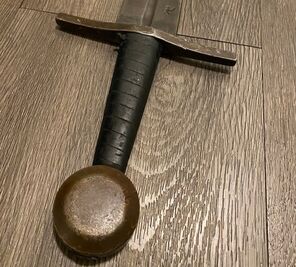 One area where the swords do show their use is in regards to the crossguard. After some time, the crossguards have come loose and rattle now. Originally I was able to hammer the crossguard back to being secure but I am unable to do so now on the older swords. That being said, I have yet to find an arming sword that this issue does not happen to after some time. My Regenyei Full Contact I.33 sword also suffers from a loose crossguard. This seems to be an inevitability with arming swords and should not be held against the Type XIV sword by VB. Cost Viktor Berbekucz swords continue to be one of the most affordable swords on the market (at least in the United States). With the price and the durability, these swords make a fantastic beginner sword purchase. Aesthetic There is something to be said about simplicity. The Type XIV sword by VB is not the flashiest training sword on the market but it definitely has the look of a sword. This sword’s simplicity feels in place with many common swords of the time and feels right at home with a priest and their student in a training setting in the early 14th century. Variability If there was any “critique” I would give to the Type XIV sword by VB it would be the variability in feel. This is partially due to the handcraftsmanship and also due to the span of time when comparing Viktor Berbekucz’s swords. Even with the variability discussed below, the quality of Viktor Berbekucz’s swords is not in question. These swords have withstood the test of time and have proven their worth. Furthermore, the newer swords feel better in the hand and also are more standardized than the swords purchased back in 2018. To further illustrate the variability, let’s take a look at the Type XIV sword by VB in my collection. Overall Length: 34.5 in Blade Length: 28.0 in Grip Length: 4.4 in Weight: 1264 grams Blade Width at Crossguard: 2.29 in Blade Width at Tip: .55 in POB Passed Crossguard (Approx.): 3 in Crossguard Length: 6.2 in The sword that started it all. This sword is best described as a “chopper”. The cuts feel slow but with the weight behind it, this sword can really back a punch with hewing cuts. Because of the weight, the sword serves well with binding actions, allowing for a fencer to easily control the bind against an opponent in most circumstances. The darker finish on this sword is the result of cold bluing I did to add some rust resistance. The bluing was done on the sword in early 2021 after years of cleaning the rust off of the blade (Texas humidity is not kind on swords). The weight feels further from the hands than with the next sword we are going to discuss. Overall Length: 35.3 in Blade Length: 28.8 in Grip Length: 4.5 in Weight: 1269 grams Blade Width at Crossguard: 2.19 in Blade Width at Tip: 0.41 in POB Passed Crossguard (Approx.): 2.8 in Crossguard Length: 6.5 in This next sword is the second sword I bought in 2018 and appears to be the oddball of the group. This sword is far narrower at the tip than the other swords. The weight of the sword feels closer to the hand as well. Overall, this sword feels nimble and even with the weight of it, this sword flows well in the cut to perform slicing actions with. Again, this sword has been blued to help with rust resistance. Overall Length: 34.0 in and 34.0 in Blade Length: 27.3 in and 27.5 in Grip Length: 4.3 in and 4.2 in Weight: 1126 grams and 1155 grams Blade Width at Crossguard: 2.23 in and 2.28 in Blade Width at Tip: 0.53 in and .52 in POB Passed Crossguard (Approx.): 2.8 in and 3.0 in Crossguard Length: 6.3 in and 6.3 in By the measurements, these swords appear more standardized than their 2018 clones. Another point of interest is the overall weight. Both of these swords are over 100 grams lighter than the 2018 swords and the improvement can be felt when performing cut drills with these swords. The overall durability appears to still be one of the best qualities of these swords though time will tell if they last longer than their stout 2018 counterparts. Who I Recommend It To The durability of these swords combined with their cost make these swords an easy recommendation for new fencers. However, do be warned, the durability is also one of the biggest drawbacks. These swords can hit hard and do not flex as much as more narrow bladed training swords. Because of this, new fencers must be careful and show good control when sparring with these to avoid injuring their sparring partners. For more advanced students, I recommend this sword for a different reason. While I prefer the feel and quickness of other swords, I still find myself sparring with these swords from time to time to practice good technique. The shortness of these blades combined with the heft of them makes it difficult to capitalize on distance with speedy attacks. These blades almost force fencers to control a bind and then close on their opponent before delivering an attack. This feature becomes critical for drilling good technique and to build strength during sparring. While these swords are great training tools, they can struggle a bit in tournaments. Their shortness and heft are their downfall against other swords on the market. While I would like to say that all tournaments are won with fantastic technique, the truth is that better equipment can provide an advantage in a fight. Will these swords win you any tournaments outright? Probably not. Will these swords help train good technique and handle themselves just fine in any fight? Absolutely. Closing Thoughts It is hard for me not to look at Viktor Berbekucz’s Type XIV sword without a feeling of nostalgia. It was my first steel training sword and was used in my first tournament. The first I.33 classes I taught featured two Type XIV swords by VB. The Type XIV Sword by VB is still one of my go-to swords as loaner equipment for students even after all these years.
I have never regretted purchasing these swords and they still help me when training I.33. The affordability combined with their durability and feel make these excellent training swords for students of all levels of experience. |
Proudly powered by Weebly
